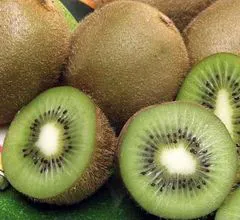 Scientists from various countries have proposed to use the dry matter content at harvesting as a worldwide quality index for Hayward kiwifruit (Actinidia deliciosa), because this parameter includes both soluble (sugars and acids) and insoluble (structural carbohydrates and starch) solids and doesn’t change during postharvest handling.
Scientists from various countries have proposed to use the dry matter content at harvesting as a worldwide quality index for Hayward kiwifruit (Actinidia deliciosa), because this parameter includes both soluble (sugars and acids) and insoluble (structural carbohydrates and starch) solids and doesn’t change during postharvest handling.Measuring the soluble solids content of kiwifruit juice at harvesting is the official method to evaluate the fruit maturity in the most kiwifruit producing countries, such as New Zealand, Italy, France, Greece, Chile, Japan and the United States.
For harvesting the kiwifruit, the minimum level of soluble solids should range from 5.5 to 6.5%, because the researchers have observed that the fruit with a content less than 6.2% can be kept in cold storage for up to 3 months only.
A US research team (Crisosto et al., 2012) has conducted several studies on dry matter content as kiwifruit quality index from 1999 to 2008 in California. The researchers have found that the dry matter and soluble solid content changed highly among the vineyards and seasons, while the titratable acidity values changed more among the seasons than among the vineyards.
After years of observations and measurements, the results demonstrate that consumer acceptance of kiwifruit is affected by the dry matter and the acidity levels. To maximize the consumer satisfaction, the researchers propose that the minimum quality index should be with ≥16.1% of dry matter when the titratable acidity is ≥1.2%, or with 15.1% of dry matter when the titratable acidity is <1.2%.
The authors have demonstrated that the dry matter content is a reliable quality index to satisfy the consumer acceptance, but it is not a reliable maturity index, because it is fundamental to consider also the soluble solid content and the fruit firmness at harvesting to storage the kiwifruit for long periods. The studies have marked that the dry matter as quality index has some limitations in predicting the long term cold storage performance of kiwifruit.
Source: Crisosto G.M., Hasey J., Zegbe J.A., Crisosto C.H., "New quality index based on dry matter and acidity proposed for Hayward kiwifruit", April-June 2012, California Agriculture, Volume 66, No. 2, pagg. 70-75. http://escholarship.org/uc/item/9xj0f3tb#page-1
